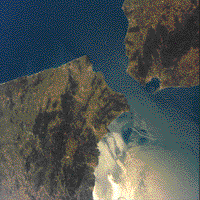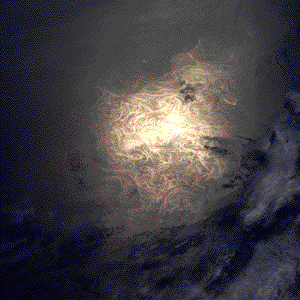
 Part 2 of 8
Part 2 of 8


The Ultimate Field Trip
An Astronaut's View of Earth
by Kathryn D. Sullivan, Ph.D.
NASA Astronaut
It's hard to explain how amazing and magical this
experience is. First of all, there's the astounding beauty
and diversity of the planet itself, scrolling across your view
at what appears to be a smooth, stately pace. Actually, it's
zooming past at about 18,000 miles an hour, but there's no
sound or wind to convince you of this fact, just the normal humming
of the orbiter's fans and pumps and the continuous gentle
breeze of the airflow system. Then there's microgravity,
or what is sometimes mistakenly called "zero gravity."
This adds another magical dimension to your Earth viewing, because
you are literally floating around the world. It's as if
the windows that were always above your head in the simulator
on Earth are now on the bottom of the most incredible glass-bottomed
boat. You float towards the window for a look with just the slightest
push against a nearby seat or control panel. Once you're
in place (it's like lying along the bottom of the boat, but
without touching it), you can move yourself around the windowpane
for better viewing angles with almost no effort at all. Turn
the tuning dial on your stereo or the volume knob on your television
and you'll get a feel for the tiny fingertip forces you can
move your body with in orbit. If you float up by the forward
seats, you have six large windows providing you with a spectacular
panorama of the Earth below, spanning at least 180 degrees of
the horizon. I'm happy to report that no amount of prior
study or training can fully prepare anybody for the awe and wonder
this inspires.

|
Strait of Gibraltar [STS41G-40-050]
Highlighted by the sunglint, internal waves called "solitons" can be seen
arching through the Strait of Gibraltar into the Mediterranean
Sea. Once a day the high tide produces sufficient energy to propagate
solitons atop the strong density boundary between the heavier,
more saline bottom water flowing west and the lighter, fresher
Atlantic water flowing east. The Strait is shallow enough to
allow the internal waves (up to 60 meters in amplitude) to manifest
themselves as crests (no more than 10 centimeters high) on the
sea surface. During World War II, German U-boats were able to
silence their motors and ride these internal waves undetected
into the Mediterranean.
|
Regardless of their preflight level of interest or Earth
training, all astronauts are entranced by the views out the window,
and whenever possible they scavenge free moments from the busy
flight plan for window gazing. Both the sweep of the view and
the detail you can see are quite remarkable. On my second flight,
at the relatively high altitude (for Space Shuttles) of 334 nautical
miles, we could see the Great Lakes quite clearly from over the
Gulf of Mexico; the Atlantic coastline of Brazil at Rio de Janeiro
from above the Andes in Ecuador; Lake Eyre, Australia, from over
Papua New Guinea.
If you're more interested in detail than grand views,
you can detect cities, airports, rivers, and the like. Over ocean
areas, catching the sun at just the right angle will let you see
amazing spiral eddies, major current boundaries, and internal
waves. In even a brief period at the window, you can get quite
an introduction to all the diverse, interrelated Earth science
disciplines - geography, geology, oceanography, ecology, meteorology - as
this great planet slides before your eyes, revealing an ever-changing
array of forms, patterns, and colors.
When several crewmembers meet at the windows to watch the
world go by, the running commentary is a delightful mixture of
science, history, personal anecdote, and childlike wonder: "Look
at that! Florida really looks like the maps!" "Wow!
No wonder this was called the Skeleton Coast - look at those
dunes" "Look at those arcs in the sunglint . . . those
must be pulses of Atlantic water flowing through the Strait on
top of the Med water." We all try to find hometowns or other
places we've been to or read about. At night, you can use
the lights of major highways and towns in the United States to
locate your hometown pretty accurately (if you know your geography!).
Some of my most memorable sights include favorite cities (Oslo,
Halifax, London), places where I've done field work or hiked
(Death Valley; the Sierra Nevada; the Wind River Range; the Chugach
Mountains and Kenai Peninsula), and places I've only dreamt
of going to (the East African Rift Valley, the Tibetan Plateau,
the Himalayas, the Galápagos).

|
The Kalahari Desert [AS17-148-22636]
The Kalahari Desert is enlarged as the drought-resistant
ground cover of the surrounding savanna is burned off by range
fires. Two such fires are seen burning in this photo taken in
1972 from Apollo 17. The scars of many generations of such fires
give the Kalahari its patchwork colors.
|
Experienced Earth observers in orbit take great pride in
their ability to instantly identify any one of the world's
deserts by its distinctive coloring and surface patterns. The
Sonoran and Chihuahuan Deserts of North America are a medium tan,
broken by the dark grays and browns of the cordilleran mountain
ranges, whereas the North African deserts are a bright orangish-red
and marked by huge wind streaks. The Kalahari is an odd patchwork
of chalky grays and black-browns; scars from immense range fires
are the cause of the distinctive patchwork pattern. Finally, the
Tibetan Plateau (the world's highest and coldest desert)
contains every imaginable shade of brown, tan, and earthy red,
along with striking blue, green, and turquoise glacial lakes.

|
Spiral Eddies off the East Coast [STS41G-41-046]
Spiral eddies spun off the inner edge of the Gulf Stream are revealed
by sunlight reflecting off a slick formed by a very thin oily
film, produced by marine organisms. Thicker oil slicks produced
by petroleum products do not spread evenly across the sea surface
but clump up in patches. Here the thin biological film has damped
down the small waves on the surface and formed a slick that manifests
the fine kinematic detail of the spiral eddies. Such ocean surface
structure can also be seen by radar, but that technology is much
more expensive than sunglint.
|

 Part 2
Part 2


Recommended citation (MLA-Style): Sullivan, K. D. 9 August 1995. "The Ultimate
Field Trip: An Astronaut's View of Earth, page 2" Earth Observations and Imaging Newsletter,
Office of Earth Sciences, NASA Johnson Space Center. <http://eol.jsc.nasa.gov
/newsletter/uft/uft2.html>
This local copy was downloaded from
http://eol.jsc.nasa.gov/newsletter/uft/uft1.html on 18 Jan 2000.
Notices: What You Need to Know About NASA JSC Web Policies
Responsible NASA official: Dr. Kamlesh Lulla
Curator: James Heydorn

 Part 2 of 8
Part 2 of 8



 Part 2 of 8
Part 2 of 8






 Part 2
Part 2

